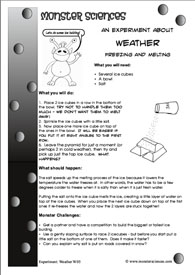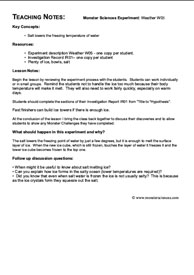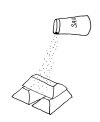Learn about how water freezes and melts, and make an ice sculpture while you’re at it!
 |
 |
Monster Sciences Weather Experiment: Freezing and Melting
What you will need:
• Several ice cubes
• A bowl
• Salt
What you will do:
1 . Place 2 ice cubes in a row in the bottom of the bowl. Try not to handle them too much – we don’t want them to melt away!
2. Sprinkle the ice cubes with a little salt.
3. Now place one more ice cube on top of the ones in the bowl. IT will be easier if you put it at right angles to the first row.
4. Leave the pyramid for just a moment (or perhaps 2 in cold weather), then try and pick up just the top ice cube. What happens?
What should happen:
The salt speeds up the melting process of the ice because it lowers the temperature the water freezes at. In other words, the water has to be a few degrees colder to freeze when it is salty than when it is just fresh water.
Putting the salt onto the ice cube melts the ice, creating a little layer of water on top of the ice cubes. When you place the next ice cube down on top of the first ones it re-freezes the water and now the 2 layers are stuck together!
Monster Challenges:
• Get a partner and have a competition to build the biggest or tallest ice building.
• Use a gently sloping surface to race 2 icecubes – but before you start put a little salt on the bottom of one of them. Does it make it faster?
• Can you explain why salt is put on roads covered in snow?
TEACHING NOTES: Monster Sciences Experiment: Weather W05
Key Concepts:
• Salt lowers the freezing temperature of water
Resources:
• Experiment description Weather W05 – one copy per student.
• Investigation Record IR01 – one copy per student
• Plenty of ice, bowls, salt
Lesson Notes:
Begin the lesson by reviewing the experiment process with the students. Students can work individually or in small groups. Remind the students not to handle the ice too much because their body temperature will make it melt. They will also need to work fairly quickly, especially on warm days.
Students should complete the sections of their Investigation Report IR01 from ”Title to “Hypothesis”.
Fast finishers can build ice towers if there is enough ice.
At the conclusion of the lesson I bring the class back together to discuss their discoveries and to allow students to show any Monster Challenges they have completed.
What should happen in this experiment and why?
The salt lowers the freezing point of water by just a few degrees, but it is enough to melt the surface layer of ice. When the new ice cube, which is still frozen, touches the layer of water it freezes it and the lower ice cube becomes frozen to the top one.
Follow up discussion questions:
• When might it be useful to know about salt melting ice?
• Can you explain how ice forms in the salty ocean (lower temperatures are required)?
• Did you know that even when salt water is frozen the ice is not usually salty? This is because as the ice crystals form they squeeze out the salt.



